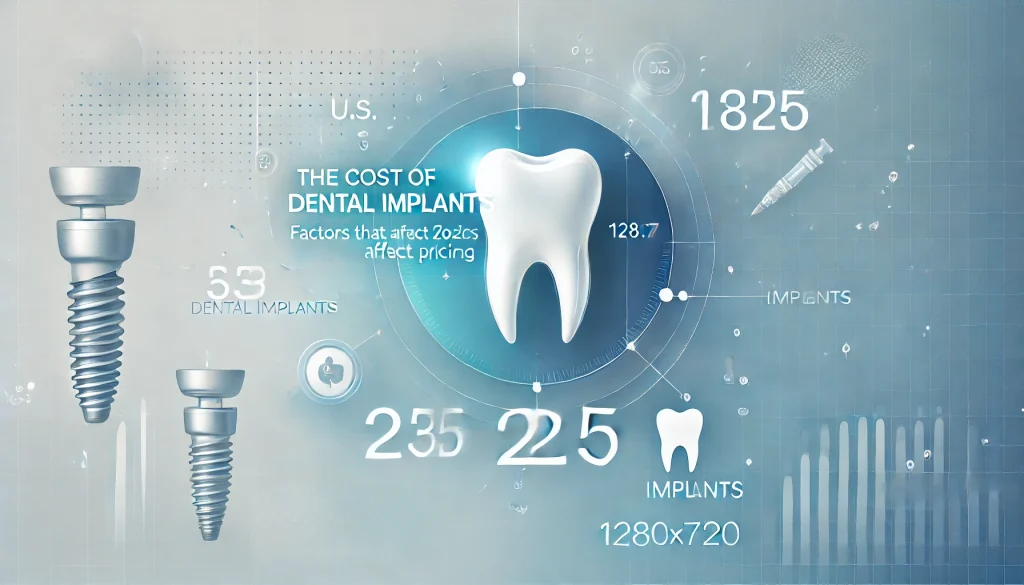US Dental Implants: Costs and Factors That Affect Pricing 2025

US Dental Implants: Dental implants have become the preferred solution for replacing missing teeth in the U.S., providing a durable, natural-looking, and long-lasting option. As we approach 2025, the demand for dental implants continues to rise, with more people seeking to improve their oral health and regain their confidence through restored smiles. However, with the rising demand comes the question: how much do dental implants cost, and what factors influence their pricing?
In this article, we’ll delve deep into the costs of US Dental Implants for 2025, covering everything from initial consultations to long-term maintenance, as well as the key factors that can significantly affect pricing. By understanding these details, you’ll be better prepared to make an informed decision about your dental implant journey.
Table of Contents
1. What Are Dental Implants?
Before diving into costs of US Dental Implants, it’s important to understand what dental implants are and why they are such a sought-after solution for missing teeth.
A dental implant is essentially a titanium post that is surgically placed into the jawbone beneath the gum line. This post acts as a replacement root, which provides a sturdy foundation for a replacement tooth or crown. Over time, the implant fuses with the jawbone in a process called osseointegration, making it a permanent solution.
The implant process involves three main parts:
- The Implant Post: A titanium screw that acts as the tooth root.
- The Abutment: A connector placed on top of the implant to hold the crown.
- The Crown: The artificial tooth that is visible in your mouth and looks just like a natural tooth.
Now that you know what a dental implant is, let’s discuss the cost of the procedure US Dental Implants.
2. Average Cost of Dental Implants in 2025
In 2025, the average cost for a single US Dental Implants is expected to range between $3,000 and $6,000. However, this price can vary significantly based on several factors, including location, the dentist’s expertise, the type of implant, and any additional procedures required, such as bone grafts or sinus lifts.
While this may seem like a hefty investment, it’s crucial to remember that dental implants offer a long-term solution. Unlike other tooth replacement options like dentures or bridges, which may need to be replaced every 5-10 years, dental implants can last a lifetime with proper care.
The cost of multiple implants or full-mouth reconstructions can be substantially higher. For example, a full set of dental implants (often referred to as an “All-on-4” procedure) can range between $20,000 and $50,000, depending on the complexity of the case.
3. Breakdown of Dental Implant Costs
The total cost of US Dental Implants procedure is made up of several components. Here’s a breakdown of what you can expect:
- Consultation and Exam: $100 – $300
- Dental X-rays or 3D Imaging: $200 – $500
- Tooth Extraction (if needed): $100 – $600 per tooth
- Bone Grafting (if required): $500 – $2,000
- The Implant Post: $1,000 – $3,000
- The Abutment: $300 – $500
- The Crown: $1,000 – $3,000
Each step in the process adds to the overall cost, but every component is necessary to ensure a successful outcome. Additionally, unforeseen circumstances like the need for a bone graft to support the implant or extractions of damaged teeth can increase the overall cost.
4. Factors That Affect Dental Implant Pricing
While the figures mentioned above provide a general idea of what to expect, many factors can influence the final cost of your US Dental Implants procedure:
1. Geographic Location
Where you live plays a significant role in US Dental Implants pricing. In major metropolitan areas like New York City or Los Angeles, dental procedures often cost more than in smaller towns or rural areas due to higher overhead expenses for dental practices.
2. Experience and Reputation of the Dentist
The expertise of the dental professional performing the implant is another crucial factor. Highly skilled implantologists with years of experience may charge more for their services, but this can be well worth the investment when considering the long-term success of the implant.
3. The Type of Implant
There are different types of US Dental Implants, and the type chosen will affect the price. For example, titanium implants tend to be more expensive than zirconia implants. Additionally, mini dental implants, which are smaller and less invasive, generally cost less than traditional implants.
4. Number of Implants Needed
Naturally, the more implants you need, the higher the cost. Full-mouth reconstruction procedures, where multiple teeth are replaced, will be far more expensive than single-tooth implants.
5. Additional Procedures
Sometimes, patients require additional procedures before they can get dental implants. This could include tooth extractions, bone grafts, or sinus lifts, which add to the overall cost of the treatment.
6. Materials Used
The materials used for the abutment and crown will also influence the cost. Porcelain crowns, for instance, are more expensive than composite crowns due to their durability and natural appearance.
5. Types of Dental Implants and Their Costs
There are several types of dental implants available, and the choice will depend on your specific needs and the recommendation of your dentist. Each type has its own cost range:
- Single Tooth Implant: As previously mentioned, this typically costs between $3,000 and $6,000 per tooth.
- Implant-Supported Bridges: These are used when multiple teeth need to be replaced. The cost can range from $5,000 to $15,000.
- All-on-4 Dental Implants: This is a popular full-arch restoration option that uses four implants to secure a full set of teeth. Costs typically range from $20,000 to $50,000 for the entire procedure.
- Mini Dental Implants: These are smaller than traditional implants and can cost between $500 and $1,500 per implant.
6. Additional Costs to Consider
In addition to the cost of the US Dental Implants and associated procedures, there are a few other expenses to keep in mind:
- Anesthesia or Sedation: If you require sedation during the procedure, this could add $500 to $1,000 to the total cost.
- Follow-up Appointments: Post-surgery check-ups are essential to ensure that the implant is healing properly. These appointments may incur additional costs.
- Maintenance and Care: While dental implants are considered permanent, they still require proper care and maintenance. This includes regular cleanings and possibly replacement of the crown over time, which could cost $1,000 to $3,000.
7. How to Save on Dental Implants
US Dental Implants are a significant investment, but there are ways to reduce the financial burden:
1. Shop Around
It’s always a good idea to get quotes from several dental professionals. Prices can vary widely between clinics, so comparing costs can help you find a more affordable option.
2. Look for Promotions
Many dental practices offer promotions or discounts, especially for new patients or for those paying in cash upfront. Keep an eye out for these deals.
3. Travel for Treatment
If you live in a high-cost area, you may want to consider traveling to a location where dental procedures are more affordable. Dental tourism is growing in popularity, with countries like Mexico offering high-quality care at a fraction of U.S. prices.
4. Consider Dental Schools
Dental schools often provide US Dental Implants procedures at reduced rates because they allow students to practice under the supervision of experienced professionals.
8. Dental Insurance and Implants
One of the most common questions about is whether insurance will cover the cost. In 2025, more dental insurance plans are starting to offer some coverage for implants, but it’s still not a guarantee.
Most insurance companies view dental implants as a cosmetic procedure, and they may only cover part of the treatment, such as the crown. However, some insurance plans now offer partial coverage for the implant post or abutment. It’s crucial to check with your provider to understand what your plan covers.
9. Financing Options for Dental Implants
Given the high cost of dental implants, many dental practices offer financing options to help make the procedure more affordable. Here are some common financing options:
- Payment Plans: Many dentists offer in-house financing, allowing patients to pay for their treatment in installments.
- CareCredit: This is a healthcare credit card that allows you to finance dental procedures, often with low or no interest if paid within a promotional period.
- Personal Loans: Taking out a personal loan from a bank or credit union is another option to consider.
Financing options can make dental implants more manageable, allowing you to get the treatment you need without paying everything upfront.
10. Conclusion: Planning for Dental Implants in 2025
As you can see, dental implant costs in 202
5 vary widely based on several factors, but with careful planning and research, you can find an option that fits your budget. Dental implants are a long-term investment in your oral health, providing a durable and aesthetically pleasing solution to missing teeth.
If you’re considering dental implants, it’s essential to consult with a reputable dentist who can guide you through the process, explain your options, and help you understand the costs involved. Don’t let the price tag deter you from regaining your smile and improving your quality of life. With the right approach, you can make dental implants a reality, even if you’re working within a budget.


